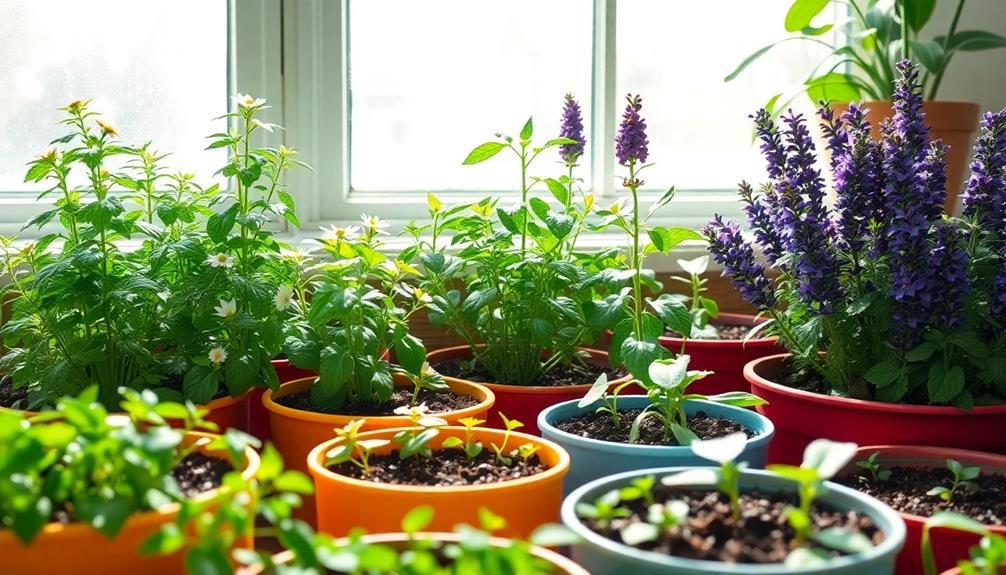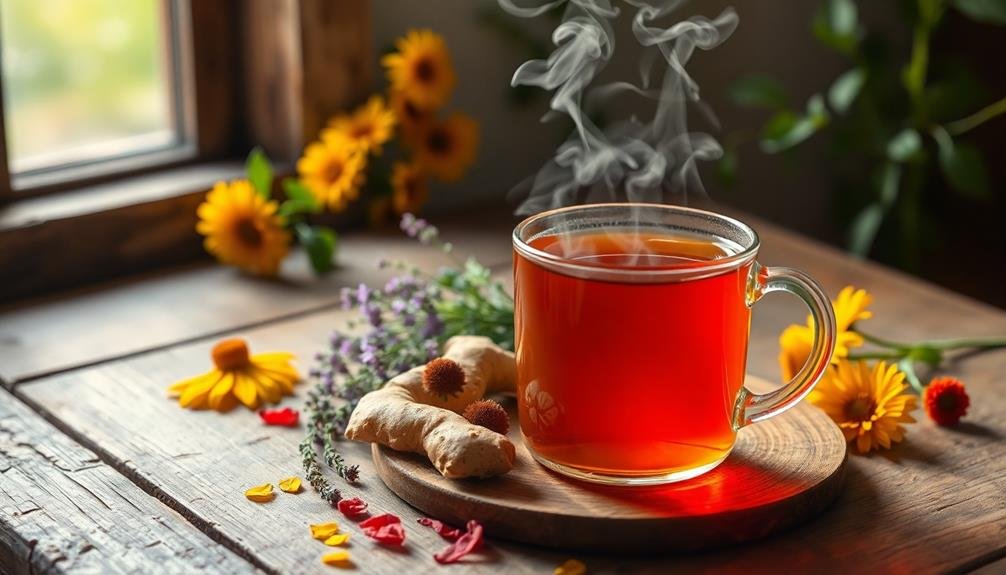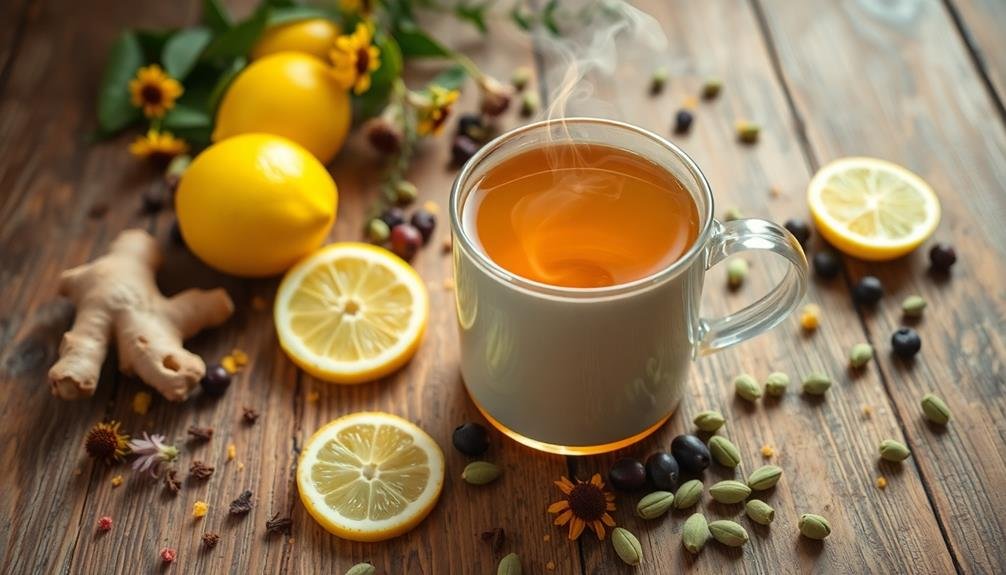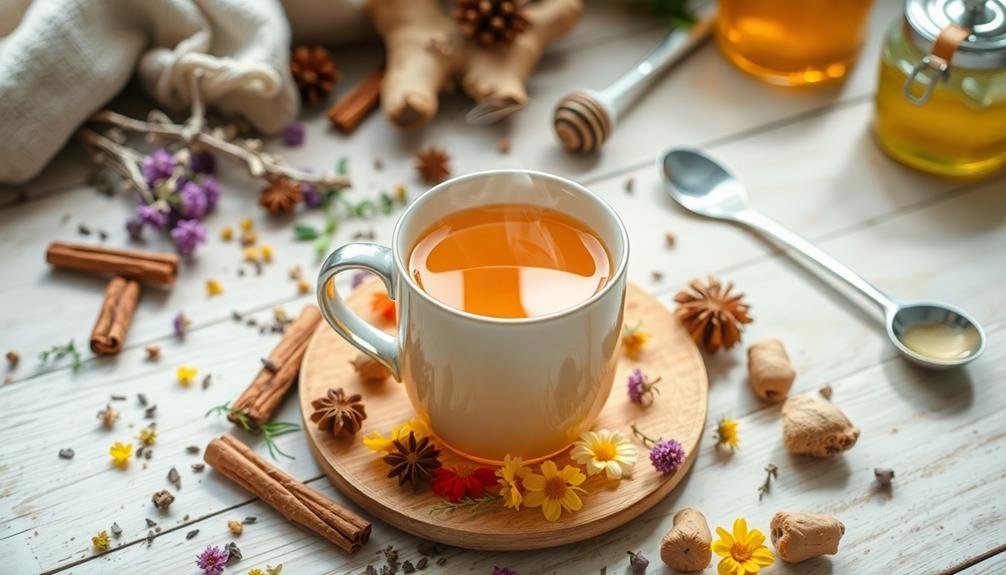You can easily craft tranquil herbal tea blends from your indoor garden by using fresh herbs like chamomile, mint, and lemon balm. Start by selecting vibrant, healthy plants that thrive indoors under bright, indirect sunlight. Combine your chosen herbs to create delightful flavor profiles, balancing calming chamomile with invigorating mint or zesty lemon balm. Experiment with different ratios and steep for 5 to 7 minutes in water around 190°F for ideal flavor. Plus, storing your blends in airtight containers will help maintain their freshness. There's much more to explore about creating and enjoying your perfect herbal tea experience!
Benefits of Herbal Tea

Herbal tea offers a variety of benefits that can enhance your overall well-being. One of the most notable advantages is its ability to promote relaxation. When you sip on a warm cup, you're not just enjoying the flavors; you're also calming your mind and body. Ingredients like chamomile and lavender are known for their soothing properties, helping you unwind after a long day.
Additionally, herbal teas can support your digestive health. Peppermint and ginger, for example, can alleviate bloating and nausea, making it easier for you to enjoy your meals.
Regularly drinking herbal tea can also boost your immune system. Many blends contain antioxidants and anti-inflammatory properties, which help your body fend off illness.
You'll find that herbal tea can also aid in hydration. It's an excellent alternative to sugary beverages, ensuring you stay refreshed without the added calories.
Ultimately, the ritual of brewing and enjoying a cup can provide a moment of mindfulness in your busy day, allowing you to reconnect with yourself.
Ideal Indoor Herbs
If you want to brew the best herbal teas, starting with the right indoor herbs is essential.
You'll need to take into account their growing conditions to guarantee they thrive in your space.
Let's explore which herbs work best for your tea and how to care for them.
Best Herbs for Tea
Wondering which herbs make the best indoor tea garden? You'll want to focus on a few standout options that thrive in pots and provide delightful flavors.
First up is mint. It's invigorating and revitalizing, perfect for a soothing cup of tea. You can choose from various types, like peppermint or spearmint, to add a unique twist.
Next, consider chamomile. Its delicate flowers create a calming tea, ideal for winding down after a long day. You'll love the subtle apple-like flavor it brings to your brews.
Lemon balm is another fantastic choice. This herb offers a bright, citrusy taste, and it's known for its calming properties, making it great for stress relief.
Lastly, don't overlook basil. While often used in savory dishes, basil tea can be surprisingly delicious, especially when combined with other herbs.
Growing Conditions Explained
To successfully grow your indoor tea garden, it's important to understand the specific conditions each herb needs to thrive.
Start with light; most herbs prefer bright, indirect sunlight, so place them near a window or use grow lights if necessary. Basil and mint love warmth, while parsley and chives can tolerate cooler temperatures.
Watering is vital. You'll want to keep the soil consistently moist but not soggy. Make sure your pots have drainage holes to prevent root rot. Check the top inch of soil; if it feels dry, it's time to water.
Humidity can also affect your herbs' health. Many herbs thrive in moderate humidity, so consider misting them or placing a shallow dish of water nearby to increase moisture levels.
Fertilizing is fundamental too. Use a balanced liquid fertilizer every few weeks during the growing season to guarantee your herbs get the nutrients they need.
Lastly, regular pruning encourages growth and prevents your herbs from becoming leggy. Snip off any flowers as they appear, as they can alter the flavor of your tea.
With these ideal growing conditions, your indoor tea garden will flourish!
Growing Conditions and Tips

When it comes to growing herbal tea plants, understanding their ideal conditions is crucial for success. Each plant has its own preferences, but you can create a thriving indoor garden by paying attention to a few key factors.
- Light: Most herbal tea plants thrive in bright, indirect sunlight. Aim for at least 6 hours of light daily. If natural light is limited, consider using grow lights to supplement.
- Soil: Use well-draining potting soil rich in organic matter. Many herbs prefer slightly acidic to neutral pH levels, so confirm your soil meets these requirements for peak growth.
- Watering: Overwatering is a common mistake. Allow the top inch of soil to dry out between waterings.
Monitor humidity levels, too; some herbs, like mint, enjoy a bit more moisture.
Crafting Your First Blend
When crafting your first herbal tea blend, start by selecting fresh herbs that resonate with your taste.
You'll want to balance flavors to create a harmonious cup that highlights each ingredient.
Selecting Fresh Herbs
Selecting fresh herbs is crucial for crafting a balanced and flavorful tea blend. When you're choosing your herbs, keep in mind the aroma, texture, and overall freshness. Fresh herbs can elevate your blend and provide a vibrant taste that dried herbs often lack.
Here are a few tips to help you select the best options:
- Look for Vibrant Colors: Fresh herbs should appear bright and lively. Wilted or discolored leaves indicate age and loss of flavor.
- Check for Aroma: Give the herbs a gentle squeeze. A strong, pleasant aroma means they're fresh and full of essential oils.
- Feel the Texture: Fresh herbs should feel firm and crisp. Soft or slimy leaves may signal spoilage.
When you bring home your selected herbs, store them properly. Wrap them in a damp paper towel and place them in a plastic bag in the fridge, or keep them in a jar of water, like a bouquet.
This keeps them fresh longer, ensuring your tea blend will be as flavorful as possible. Enjoy the process of selecting and experimenting with your herbs; it's a crucial step in creating a delightful tea experience!
Balancing Flavors Together
Creating a harmonious herbal tea blend is an exciting journey that invites you to explore various flavors and aromas. Start by choosing a base herb, like chamomile or peppermint, which will provide a strong foundation.
Then, consider adding complementary herbs to enhance the flavor profile. For instance, if you choose chamomile, think about pairing it with a hint of lemon balm for brightness or a touch of lavender for floral notes.
Next, balance the flavors by incorporating one or two contrasting herbs. If you're using peppermint as your base, adding a spicy element like ginger can create an invigorating experience.
It's important to remember that each herb has its own strength; start with small amounts and adjust according to your taste.
Don't hesitate to experiment! Keep notes on the ratios you use so you can replicate your favorite blends or tweak them for improvement.
Once you've crafted your blend, steep a small sample to assess how the flavors meld together. This is where the magic happens—discovering what works for your palate is key to creating a blend you'll love.
Enjoy the process and let your creativity shine!
Brewing Techniques Overview
After you've crafted your herbal tea blend, it's time to focus on brewing techniques that will bring out the best flavors. Proper brewing is essential to access the full potential of your carefully selected herbs. Here are some key techniques to reflect on:
- Temperature Control: Different herbs require different water temperatures. For delicate leaves, aim for lower temperatures, while sturdier herbs can handle boiling water.
- Steeping Time: Each blend has its ideal steeping time. Generally, 5 to 7 minutes works well for herbal teas. Experiment to find the perfect balance that suits your taste.
- Teapot Choice: Select a teapot that retains heat well. Materials like ceramic or glass can enhance the brewing process, allowing the flavors to meld beautifully.
To brew your first blend, start by measuring out your herbs based on your preferences. Pour hot water over the blend and cover it to trap the flavors.
After the recommended steeping time, strain the tea and enjoy the unique taste of your creation. Remember, practice makes perfect, so don't hesitate to adjust your techniques!
Flavor Profiles to Consider

When crafting herbal tea blends, reflecting on diverse flavor profiles can elevate your experience. You'll want to think about how different herbs and plants complement each other, creating a balanced and enjoyable cup. Here are some key flavor profiles to reflect on:
| Flavor Profile | Example Herbs | Suggested Pairings |
|---|---|---|
| Earthy | Chamomile, Sage | Mint, Lemon Balm |
| Citrusy | Lemongrass, Lemon Verbena | Ginger, Peppermint |
| Spicy | Cinnamon, Ginger | Clove, Cardamom |
Combining these profiles will not only enhance the taste but also provide various health benefits. For instance, earthy herbs can ground your blend, while citrusy notes can uplift and refresh. Spicy elements add warmth and complexity, perfect for soothing cold days or for a cozy evening.
Experiment with different ratios to find your perfect blend! Don't hesitate to adjust based on your taste preferences and the desired effect, whether it's relaxation, invigoration, or digestion support. Remember, the magic lies in balance and harmony among the flavors you choose. Enjoy the creative process!
Brewing Techniques for Relaxation
Finding the right balance in your herbal tea blends is just the beginning; how you brew them plays a significant role in maximizing their relaxing effects. To create that perfect cup, start by using fresh, quality ingredients. The temperature and steeping time matter, too.
Here are a few techniques to enhance your experience:
- Water Temperature: Use water around 190°F (88°C) for most herbal teas. If it's too hot, you might extract bitter flavors that can disrupt your relaxation.
- Steeping Time: Allow your tea to steep for 5 to 7 minutes. This duration helps release the calming properties of the herbs without overpowering the blend.
- Mindful Preparation: Turn your brewing process into a ritual. Focus on the aromas and colors as you prepare your tea. This mindfulness can enhance your overall relaxation.
Experiment with these techniques to find what works best for you. Remember, brewing herbal tea is an art that invites you to savor each sip while also allowing those soothing qualities to work their magic.
Enjoy the process, and let your cup become a sanctuary of relaxation.
Storing Your Herbal Blends

Proper storage of your herbal blends is essential for preserving their flavors and therapeutic properties. To keep your teas fresh, start by using airtight containers made from glass or stainless steel. These materials prevent moisture and light from degrading your herbs.
Avoid plastic containers, as they can leach chemicals and absorb odors.
Store your blends in a cool, dark place, away from direct sunlight and heat sources. A pantry or cupboard works well, but make sure it's not too humid. Label each container with the blend's name and the date you made it, so you can track freshness.
When you're ready to use your blends, only take out what you need, and seal the container immediately to minimize exposure to air.
For longer-term storage, consider freezing your herbal blends in an airtight bag. This method helps retain their potency and flavor for several months.
Frequently Asked Questions
How Long Do Herbal Blends Typically Last Before Losing Potency?
Herbal blends usually last about six months to a year before losing potency. To keep them fresh, store them in a cool, dark place, away from moisture and direct sunlight, ensuring you enjoy their full flavor.
Can I Use Dried Herbs From My Pantry for Tea Blends?
Yes, you can use dried herbs from your pantry for tea blends. Just make certain they're fresh enough to provide flavor and potency. Experiment with different combinations to find the perfect brew that suits your taste.
Are There Any Herbs to Avoid When Crafting Tea Blends?
When crafting tea blends, you should avoid herbs like sassafras, comfrey, and wormwood. These can have toxic effects or strong flavors that overpower your blend. Always research each herb's safety and potential interactions before using them.
What Tools or Equipment Do I Need for Blending Herbs?
To blend herbs effectively, you'll need a sharp knife, cutting board, storage jars, and a scale for measuring. A mortar and pestle or grinder helps achieve the desired consistency, ensuring your blends are aromatic and flavorful.
How Can I Customize Blends for Specific Health Benefits?
To customize blends for specific health benefits, you'll research herbs known for those effects, experiment with ratios, and taste-test until you find the perfect balance. Keep track of ingredients to refine your blends over time.
In Summary
By cultivating your own indoor herbs and crafting tranquil herbal tea blends, you're not just enjoying a soothing beverage—you're creating a calming ritual. With a little knowledge about growing conditions and flavor profiles, you can easily customize your blends to suit your taste. Remember to experiment with different brewing techniques and store your herbal creations properly for maximum freshness. So, embrace the serenity of your indoor garden, and sip your way to relaxation with every cup.





Leave a Reply